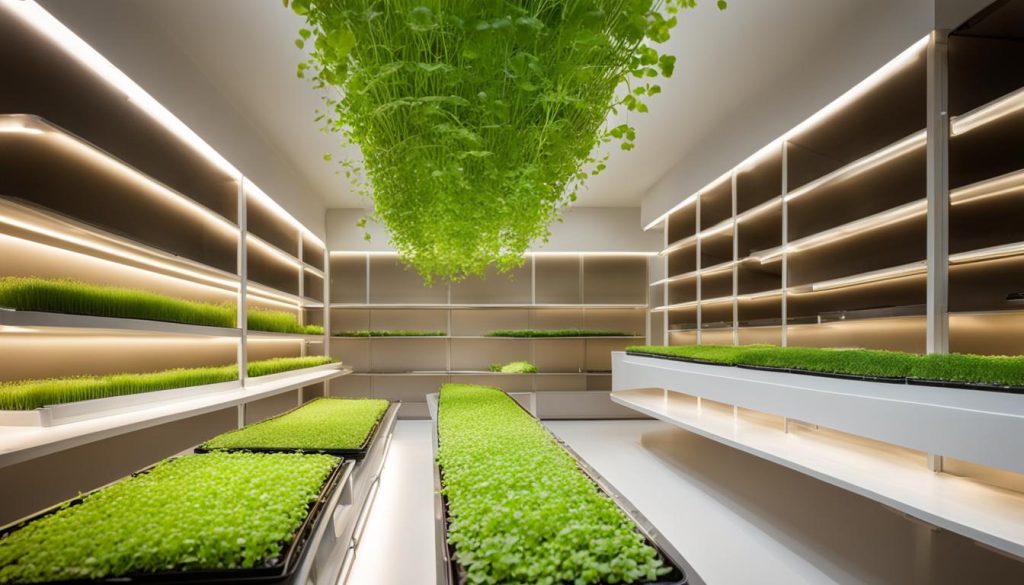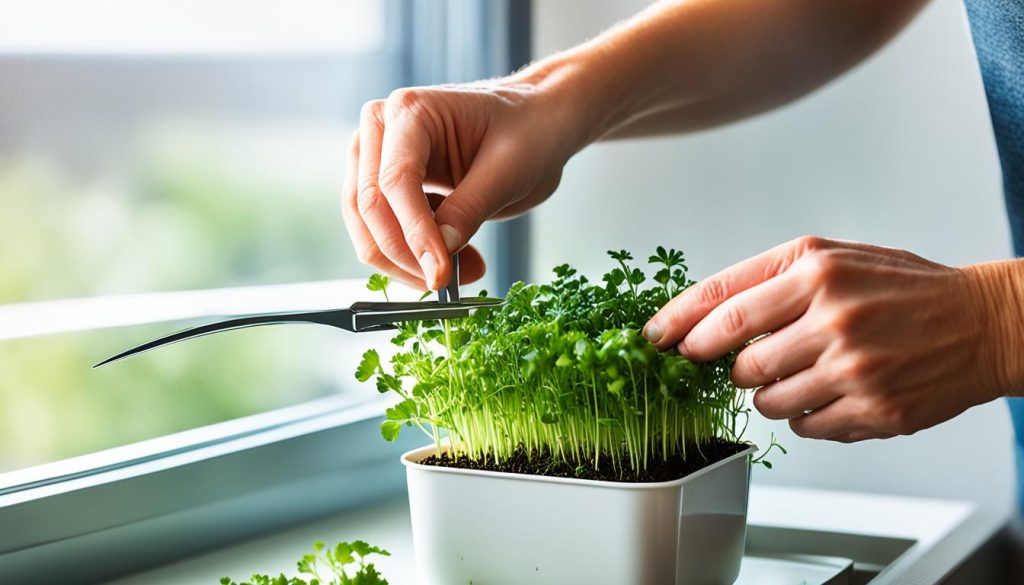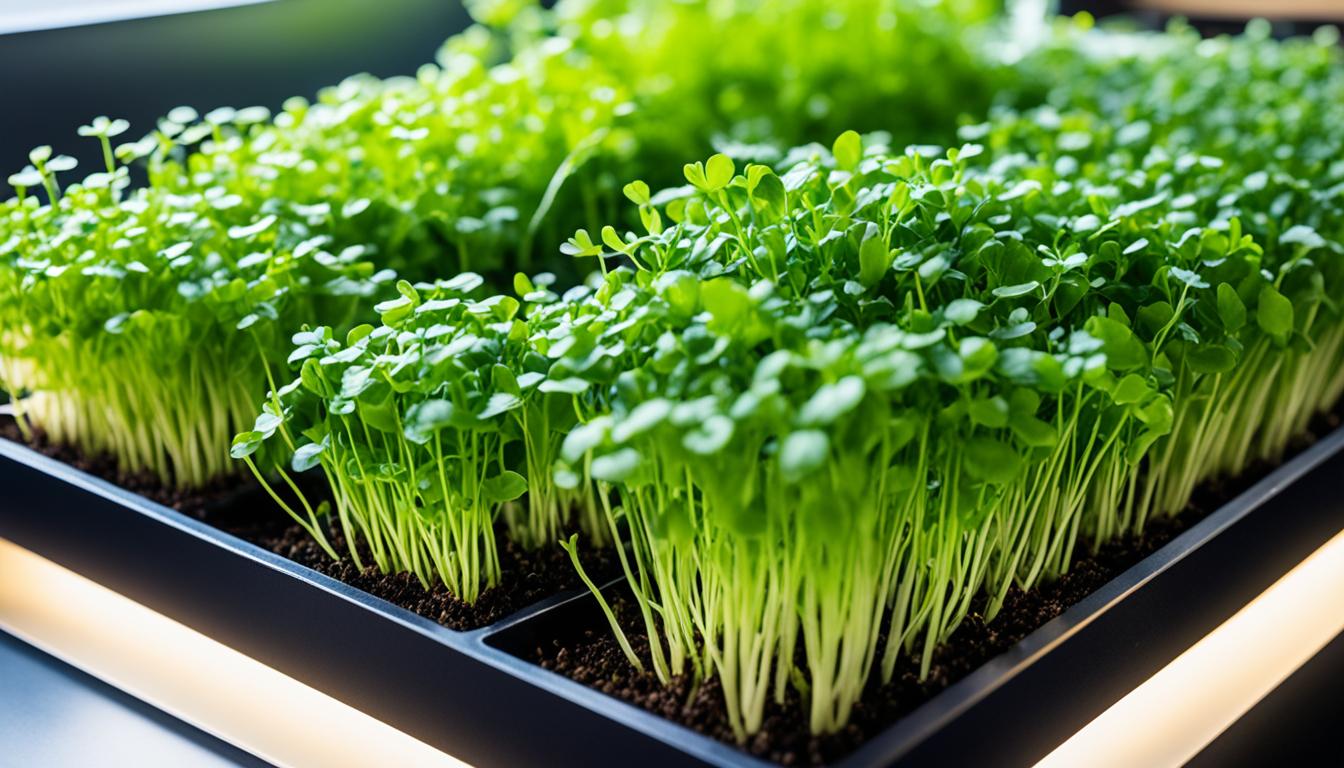Discover the joy of cultivating fresh cilantro microgreens right in your own kitchen. With a few simple steps and the right conditions, you can harvest and enjoy these vibrant greens packed with nutritional benefits. Whether you’re an experienced gardener or new to the microgreens world, this guide will show you just how easy and rewarding it is to grow cilantro microgreens. Plus, opting for organic cilantro microgreens means you’re choosing a healthy, sustainable path for both you and your environment. Ready to add a burst of flavor to your meals?
Understanding Cilantro Microgreens
Delving into the world of microgreens reveals a variety of flavors and nutritional benefits, particularly when exploring the sprouted form of Coriandrum sativum, better known as cilantro. These tender shoots, harvested at their peak of flavor and nutrient density, are making a grand entrance into the culinary scene. They possess a unique combination of taste and nutritional value that sets them apart from their mature plant counterpart. As we uncover the characteristics of cilantro microgreens, their culinary versatility, and their concentrated nutritional profile, one can’t help but be tempted to include these verdant greens into everyday meals.
What Are Cilantro Microgreens?
Cilantro microgreens emerge from the first stages of growth after the seedling breaks through the soil, presenting themselves proudly with cotyledon leaves. These baby greens encompass a milder and more agreeable flavor compared to the sometimes divisive, bold essence of full-grown cilantro leaves. The unique qualities of cilantro microgreens render them a culinary gem, providing not just aesthetic value to dishes but also introducing a fresh, herbaceous note ideal for countless cilantro microgreens recipes.
Distinguishing Cilantro Microgreens from Adult Cilantro
Moreover, cilantro microgreens stand out from their mature counterparts due to their cultivation process. These delicate greens do not require the deep, extensive root systems that fully developed cilantro plants do. As such, they can be cultivated in shallow trays, making them a convenient addition to kitchen gardens and windowsills. This key difference not only influences their ease of growth but also impacts their texture and taste, making them a sought-after ingredient for chefs and home cooks alike.
Nutritional Advantages of Cilantro Microgreens Over Mature Herbs
When it comes to the benefits of cilantro microgreens, one cannot gloss over their nutritional impact. These young plants are powerhouses of concentrated nutrients including carotenoids, vitamin E, and vitamin K. Such cilantro microgreens nutrition aids in reinforcing the body’s defenses, supporting immune function, and promoting eye health. The presence of vitamins also plays a crucial role in maintaining healthy blood coagulation, an essential process in our well-being. As we navigate through the vast landscape of nutritional foods, cilantro microgreens offer a tantalizing option that is both delicious and wholesome.
The Misconceptions about Growing Cilantro Microgreens
Many aspiring gardeners shy away from the journey to grow cilantro microgreens, believing it to be a task laced with complexity and hidden challenges. This assumption, however, is rooted in misconceptions that have deterred countless enthusiasts from exploring the rewarding practice of nurturing these fragrant greens. In dispelling these myths, we hope to encourage more individuals to embark on the fulfilling endeavor of cultivating organic cilantro microgreens.
One prominent myth is the supposed necessity of pre-soaking cilantro seeds, a technique inherited from traditional gardening wisdom. While this process was once touted as essential, modern growers have found that cilantro microgreens can thrive without it. It’s quite refreshing to learn that both soaked and unsoaked seeds are capable of developing into lush, healthy microgreens. This realization simplifies the growing process significantly, making it more accessible and less intimidating for those just starting out.
It is time to change the narrative and shed light on the truth that to grow cilantro microgreens is not an art reserved for the green-thumbed elite. Rather, it’s a straightforward, enjoyable process that rewards patience with a verdant harvest. As the veil of complexity lifts, the path to growing organic cilantro microgreens becomes clear, inviting gardeners of all levels to nurture these delightful sprouts confidently.
Start Your Journey with Cilantro Microgreens
Embarking on the adventure of growing cilantro microgreens at home is an exciting foray into the world of indoor gardening. With their zesty flavor and nutritional benefits, these tiny greens are a powerhouse of both taste and health. Let’s guide you through the initial steps of choosing the right seeds and gathering the essential supplies to ensure your microgreen garden thrives.
Selecting the Right Cilantro Seeds
Your journey to successful microgreen cultivation begins with the very first decision – choosing high-quality seeds. Varieties such as ‘Slow Bolt’ or ‘Leisure Splits’ are favored by both home gardeners and professional growers for their strong, robust flavors and reliable growth patterns. For those who are environmentally conscious or seeking to maintain an organic garden, there are plenty of options for OMRI-approved, organic cilantro seeds available. When you decide to buy cilantro microgreens seeds, opt for reputable brands to ensure that your greens have the best start in life.
Essential Supplies for Homegrown Microgreens
With seeds in hand, you’ll need to consider the equipment necessary to facilitate the growth of your cilantro microgreens. Your shopping list should include planting trays outfitted with proper drainage holes, which will prevent water from pooling and potentially damaging the emerging plants. Additionally, a fine-grained soil mix or coconut coir will serve as the ideal growing medium, offering a balance of aeration and moisture retention. Don’t forget a consistent light source to encourage photosynthesis – grow lights are a great solution for indoor environments. These fundamental supplies lay the groundwork for a microgreen garden that’s not only healthy but also primed for producing those richly flavored greens you’re looking forward to.
Cilantro Microgreens Growing Conditions Explained
To achieve a harvest of flourishing organic cilantro microgreens, one must cultivate them under certain conditions that foster their growth. Providing consistent light plays a pivotal role, making a high-quality lighting system like an Agrobrite T5 indispensable. These fixtures guarantee that your growing healthy microgreens have the light exposure they necessitate to thrive.

While embarking on the initial germination phase, darkness envelopes the seeds, which should be nurtured in cooler temperatures, ideally around 70°F (21°C). This phase also demands duly attentive watering practices. Hydration is essential, but it is equally important to avert oversaturation to prevent the seeds from rotting. The discourse on whether to soak the seeds prior to planting continues, but empirical observations have demonstrated that cilantro microgreen seeds are amenable to germinating with or without pre-soaking—an indication that growers can exercise a degree of flexibility when it comes to the inaugural watering practice.
Overall, the guiding principle to growing healthy microgreens such as cilantro is to foster a balance: adequate light and water, coupled with an environment that simulates the coolness and darkness of early life beneath the soil. By adhering to these conditions, gardeners both novice and expert alike can expect to enjoy lush, flavorful yields of organic cilantro microgreens.
Cilantro Microgreens: A Step-by-Step Growing Guide
If you’re wondering how to grow cilantro microgreens, the journey to lush, aromatic greens begins in the simplest of ways. Start with a tray filled with dampened soil or a preferred growing medium. The key to lush microgreens is even seed distribution – sprinkle the cilantro seeds across the surface without additional soil coverage, allowing them full access to light once they germinate.
Creating the perfect germination environment is all about balance. Your seeds need uninterrupted moisture and darkness during their early days, which usually takes about 2-6 days. This is your cilantro’s most critical time – */keep the conditions just right/**, and you’ll be rewarded with the emergence of delicate sprouts.
Once the seeds have sprouted, it’s time to shine the spotlight, quite literally. Positioning a grow light above your seedlings simulates the nurturing power of the sun and **encourages a vibrant grow**. A consistent light source isn’t just for show; it’s a vital ingredient in the recipe for growing cilantro microgreens.
Watering is an art form when nurturing your cilantro. Utilize bottom watering to keep moisture levels optimal without inviting unwanted fungal guests. This technique ensures that your microgreens drink up just as much as they need. Persistence is your friend; a regular watering routine will see your cilantro microgreens develop into the zesty leaves packed with flavor and nutrients, ready to elevate any dish.
By following this cilantro microgreens step-by-step guide, you’ll find that with each day’s tender care, you draw closer to a bountiful harvest. It’s a continuous cycle of attention and adjustment, but the pay-off is in the freshness and nutrition that only homegrown microgreens can provide.
Harvesting Your Homegrown Cilantro Microgreens
After tenderly nurturing your cilantro microgreens, the moment to reap the rewards of your effort arrives. Harvesting cilantro microgreens is an exciting and straightforward process that ensures your dishes are graced with the most aromatic and nutrient-packed greens possible. By identifying the best time to harvest microgreens, you ensure peak flavor and nutrient density, making every snip of your scissors profoundly satisfying.
When to Harvest for Optimal Flavor and Nutrients
The window for harvesting your cilantro microgreens is not just about picking a time that works for you—it’s about syncing with the plants’ natural growth cycle for the utmost culinary experience. Generally, the prime time falls between the 10th and 20th day post-germination, marked by the presence of the first true leaves. This is when your microgreens are at their aromatic peak, bursting with flavors and nutrients.

Techniques for Harvesting Microgreens
With the ideal harvest time pinpointed, your technique is the next cornerstone of harvesting cilantro microgreens. A pair of clean kitchen scissors is all that stands between you and your bounty. Gently snip the stems just above the soil line to minimize injury to the plant and maximize freshness. For an extra touch of preparation, hold off watering your microgreens 12 hours before harvesting to reduce moisture, simplifying your post-harvest process whether you’re aiming for instant use or storage. Remember, harvesting can be done incrementally, providing you with just the right amount of freshness whenever needed.
Storing and Preserving Your Cilantro Microgreens
Once you’ve harvested your cilantro microgreens, the journey to maintaining their zesty flavor and crispness begins. Storing cilantro microgreens effectively is simple, yet it can make all the difference in prolonging their shelf life. The initial step is to gently wash the microgreens to remove any soil or debris. This ensures they’re clean and ready for culinary use at a moment’s notice.
Next, comes the drying process. Lay them out on paper towels and pat them dry with care. Excess moisture is a key contributor to the degradation of your greens, so it is crucial to minimize it before storing. Once your microgreens are sufficiently dry, it’s time to think about storage containers.
For preserving fresh microgreens, an airtight container is your best ally. This will keep out the air that accelerates wilting and spoilage. However, remember to pack them loosely to avoid crushing their delicate structures and to allow for slight air circulation, which prevents molding.
Finally, place your airtight container in the refrigerator. In this chilled environment, you create the perfect conditions to keep your cilantro microgreens fresh and inviting. When done properly, you can extend their usability, allowing you to enjoy their distinctive flavor for up to 10 days.
By following these tips, you’ll find that your fresh microgreens remain a vibrant and flavorful addition to your meals, while also reducing food waste. It’s a win-win for both you and your palate!
Unique Ways to Enjoy Your Fresh Cilantro Microgreens
As you harvest your cilantro microgreens, vibrant and teeming with flavor, the question arises: how to use cilantro microgreens to elevate your culinary masterpieces? The beauty of these tiny greens lies in their versatility. Incorporating them into a variety of dishes not only enhances the taste but also adds a wonderful touch of green that’s as appealing to the eye as it is to the palate.
Incorporating Cilantro Microgreens into Recipes
When considering cilantro microgreens recipes, let your imagination take the lead. Use these greens to impart a fresh, citrusy edge to your salsas or guacamole, blending perfectly with the zest of lime and the richness of avocado. For those who love a culinary challenge, try creating a cilantro microgreen-infused oil, which can serve as a distinctive dressing for salads or a finishing oil for grilled fish or chicken, adding a sophisticated burst of flavor.

Using Cilantro Microgreens as Garnish
Garnishing with cilantro microgreens is as much about aesthetics as it is about taste. The delicate leaves can transform a simple plate into a restaurant-style dish with nothing more than a sprinkle on top. Picture a juicy steak or a vibrant curry, the microgreens add not only a punch of flavor but also a delightful contrast in texture. Even a mundane dish like scrambled eggs becomes visually exciting and tastier with these greens artfully applied.
Maximizing Flavor in Various Dishes
For those eager to maximize the flavor of their meals, cilantro microgreens offer an exciting opportunity. Blend them into smoothies for an unexpected yet delightful twist, or fold them into fresh spring rolls for an herbal kick. These microgreens are more than just an ingredient; they are a ticket to a world of heightened tastes and creative kitchen ventures. Not to forget, their addition to any dish makes for an instant elevation of your home cooking to the echelons of gourmet flair.
Incorporating these versatile greens into your diet is not only easy but also inspirational. Be it through a burst of flavor in a dip or adding elegance to a main course as a garnish, cilantro microgreens are a simple, yet extraordinary addition to the home chef’s repertoire.
Health Benefits of Cilantro Microgreens
Exploring the health benefits of cilantro microgreens reveals an impressive array of nutritional advantages that can bolster one’s well-being. Not only are these petite plants a culinary delight, but they also come packed with a concentration of essential vitamins and antioxidants. Let’s delve into the specifics of how cilantro microgreens can positively impact your health.
Contribution to Eye Health
Rich in carotenoids such as lutein and zeaxanthin, cilantro microgreens play a critical role in maintaining optimal eye health. These antioxidants are known to shield the eyes from harmful blue light, potentially reducing the risk of age-related macular degeneration. Incorporating these greens into your diet is an easy way to support your vision.
Supporting Healthy Immune Function
In the quest for a robust immune system, cilantro microgreens nutrition should not be overlooked. The presence of vitamin E in these greens is key to enhancing the body’s defense mechanisms against illness and infection. A sprinkle of cilantro microgreens may contribute more to your health than just a burst of flavor on the palate.
The Role in Blood Coagulation
Vitamin K is abundant in cilantro microgreens, and it plays an essential role in blood coagulation. Consuming adequate amounts of this vitamin is vital for the proper function of blood clotting processes, ensuring that the body can heal wounds effectively and maintain circulatory health.
Overcoming Challenges in Growing Cilantro Microgreens
As delightful and rewarding as it is to grow cilantro microgreens, individuals may sometimes face hurdles that can affect the health and yield of their plants. From dealing with seeds that resist sprouting to battling the onset of mold, learning to navigate and rectify these issues is a key part of ensuring a successful microgreen garden. In this guide, we will share insights on the common issues that may arise and the most effective strategies to address them.
Addressing Common Growing Pains
Every gardener’s journey includes learning to deal with the unforeseen challenges that plants can present. For cilantro microgreens, one might find cilantro microgreens growing problems such as uneven growth or yellowing leaves which are often indicators of underlying issues with water, light or nutrient imbalance. Cultivating a practice of regular observation helps in identifying such issues early on and adjusting care accordingly.
Tips for Managing Germination Issues
Germination is a crucial phase in the life of any plant, and cilantro microgreens are no exception. Factors such as soil temperature, moisture levels, and seed quality all play pivotal roles in germination success. By ensuring seeds are sown in a fine-grained, evenly moist medium and kept in a dark, adequately warm environment, germination rates can be substantially improved. Moreover, patience is key as cilantro can be one of the slower seeds to sprout.
Preventing Mold and Other Microgreen Ailments
Preventing mold in microgreens is paramount in safeguarding your greens’ health and your own. Mold thrives in damp, poorly ventilated spaces, so it’s essential to provide ample airflow and control moisture levels within your growing area. Adequate spacing between seeds and ensuring cleanliness of grow trays and tools can also help prevent the occurrence of mold and other ailments non-beneficial to your crop’s growth.


